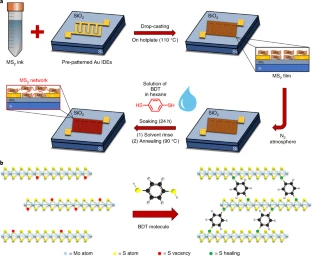Nanowerk February 25, 2021
Semiconducting transition metal dichalcogenides (TMDs) can be used to make conductive inks to manufacture printed electronic and optoelectronic devices. However, defects in their structure may hinder their performance. To boost the electrical performance of TMD based devices an international team of researchers (France, Ireland, UK) has developed ‘molecular bridges’- small molecules that interconnect the TMD flakes. The molecular bridges double up as walls, healing the chemical defects at the edges of the flakes and eliminating electrical vacancies that would otherwise promote energy loss and they provide researchers with a new tool to tailor the conductivity of TMD inks on demand. They achieved a reproducible increase by one order of magnitude in field-effect mobility, current ratio and switching time for liquid-gated transistors. Their functionalization strategy is a universal route to simultaneously enhance the electronic connectivity in TMD networks and tailor on demand their physicochemical properties according to the envisioned applications…read more. TECHNICAL ARTICLE

Functionalization strategy for production of covalently interconnected MS2 networks. Credit: Nature Nanotechnology (2021)